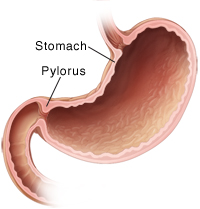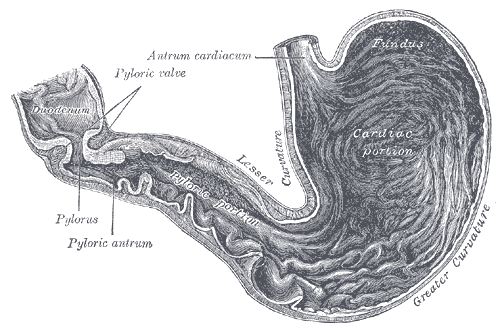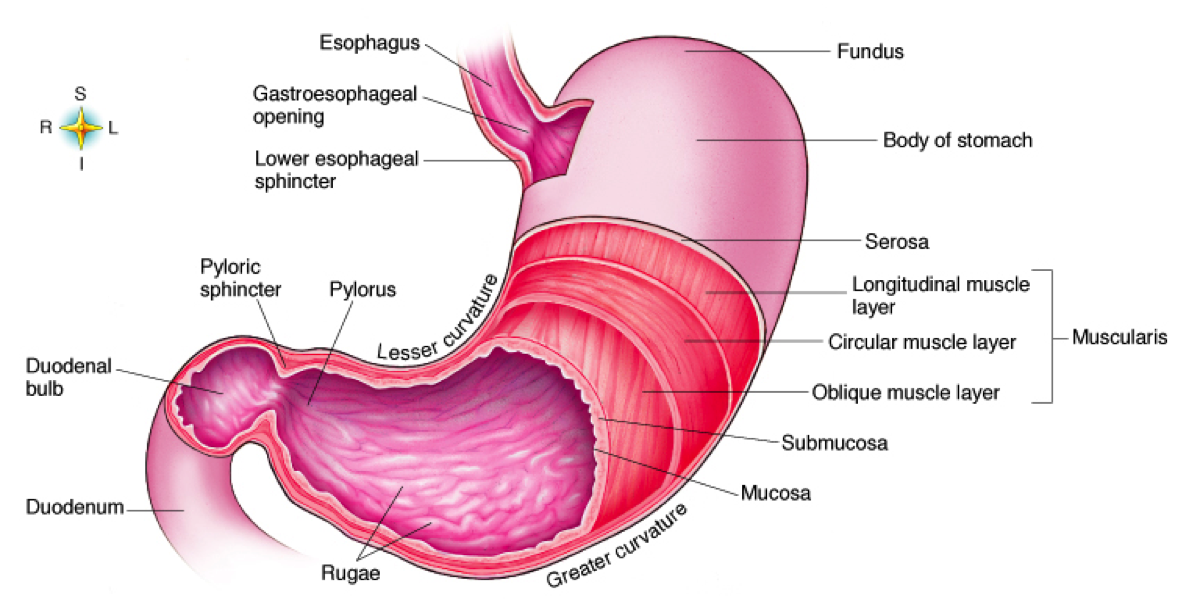Pylorus Definition
It is a small constriction at the lower end of the stomach that directly opens into the duodenum. The aperture generally marks the end of the stomach and the beginning of the small intestine. It is often mistaken as keratosis pilaris, a common, autosomal dominant condition marked by rough, red, bumps on the skin.
Pylorus Location
As aforementioned, the passage is located in the upper abdomen. The exact location of the Pylorus is marked by a circular groove on the surface of the stomach, which is the duodenopyloric constriction.
In simple words, the strong ring (also known as the Pyloric valve or sphincter) is composed of smooth muscles positioned at the end of the pyloric canal that allows food to get transferred from the stomach to the duodenum.
Pylorus Anatomy/Description
It is a cone-shaped structure covered with a mucous-membrane lining that consists of the following parts:
- Pyloric antrum: It is the first section of the pyloric part of the stomach that closes partially or completely from the remainder of the gastrointestinal tract during digestion. It is bulgy and connects to the body of the stomach. A small groove demarcates it from the second part of the aperture.
- Pyloric canal: This narrow, tubular portion of the stomach ends at the gastroduodenal junction.
At the end of the opening between the stomach and the small intestine, there is a compact ring of smooth muscle or valve, called pyloric sphincter. Thickening of the lower region of the pyloric canal gives rise to this structure. It clearly separates the stomach from the duodenum by closing the natural orifice whenever required. The pyloric valve is innervated by the sympathetic nerve called celiac ganglion in the upper abdomen.
Pylorus Function
The inner surface of the aperture is lined with gastric mucosa, which secretes gastric juices to promote digestion. The mucosa is normally covered with thick mucus secreted by the columnar epithelial cells. It chiefly serves the following two purposes:
- Lubrication of food masses in order to facilitate movement within the stomach
- Formation of a protective layer over the lining epithelium
The primary function of the cone-shaped constriction is to prevent regurgitation of food from the small intestine. It also aids in the proper movement of the undigested food through the intestinal tract. The pyloric sphincter opens periodically to permit small quantities of well-emulsified food to enter the duodenum. Once the duodenal region is completely filled, the pyloric valve contracts and shuts off due to increase in pressure. The food is pushed deeper into the remaining portions of the intestine with the help of peristaltic waves in the duodenum.
Pylorus Disorders
The small circular opening is often affected with pyloric stenosis. In this condition, the aperture undergoes narrowing due to progressive thickening of the pyloric canal, causing uncontrollable vomiting and abdominal pain. The condition is common in infants that involve thickening of the pylorus muscles, thus preventing food from entering the small intestine. Presence of tumours in the pyloric canal can also block the aperture and cause severe discomfort. Pancreaticoduodenectomy/
In some instances, the conical passage may remain in a patulous/open state to allow the passage of food into the intestine before the completion of gastric digestion. This occurs due to pyloric spasm in which the sphincter undergoes a sudden, involuntary contraction. A deformed aperture can also be the cause of acid reflux. Helicobacter pylorus (H. pylori) is a bacterium that causes chronic inflammation of the inner lining of the stomach and subsequent formation of ulcers. A broad spectrum of antibiotics is needed to treat this condition. Other associated clinical distress caused to the Pylorus includes Pyloric tumours and Pyloric gland adenoma.
Pylorus Diseases- Symptoms
Symptoms of Pyloric stenosis are noticeable within 3-4 weeks of a baby is born. The condition is, however, rare in babies older than 3 months. The signs and symptoms incorporate:
- Feeling of hunger all the times- Babies suffering from Pyloric stenosis show persistent hunger. They have the tendency to feel the urge of eating immediately after vomiting.
- Forceful vomiting just after feeding- The baby may have the tendency to vomit immediately after breastfeeding. The symptom is marked by forceful vomiting that may spill up to a few feet away (known as projectile vomiting). Initially, the vomiting is mild but gradually it becomes severe with marks of blood in it.
- Abnormal changes in bowel movements- Since food is blocked from entering the intestines, the babies may always suffer from constipation.
- Contractions of the stomach- The babies feel contractions in the stomach that appear like waves or ripples across the upper abdomen just after feeding, but before vomiting. The contractions of the stomach muscles force the food to storm out through the narrowed pylorus.
- Weight issues- Since the condition induce vomiting it prevents the baby from gaining weight. Thus, weight loss is a continuous problem associated with this medical condition.
The symptoms related to pyloric valve tumour or stomach polyps are an indication of stomach cancer. They include:
- Blood in stools
- Vomiting
- Stomach pain
- Anaemia
- Tenderness and when the stomach is pressed
Pylorus Diseases- Causes
Pyloric stenosis is not present at birth but it has the tendency to develop afterwards. Although its actual reason is not known, the reasons are mostly attributed to environmental and genetic factors. These are:
- Race- The condition is common in Caucasians of the northern European region.
- Sex/gender- The condition is more common in boys than girls. It is most likely to develop in a firstborn child, especially if it is a boy.
- Smoking at the time of pregnancy- Smoking has the tendency to aggravate the risk of pyloric stenosis.
- Family history- The disorder is highly detectable in descendants belonging to families showing a history of Pyloric stenosis. It is most likely to attack 10 per cent of female descendants and 20 per cent of male descendants of mothers who had the condition.
- Bottle-feeding- Bottle feeding rather than breastfeeding increase the risk of Pyloric stenosis.
- Premature birth- Prematurely born babies are more susceptible to developing Pyloric stenosis than full-term babies.
- Antibiotic usage after birth- Those babies who are administered antibiotics in the initial week of life are more likely to develop Pyloric stenosis. Even mothers who took certain medications in their late pregnancy have the chances of having their babies develop Pyloric stenosis.
The causes of stomach polyps or tumours in the pyloric valves are as follows:
- Familial adenomatous polyposis is an inherited syndrome that leads to the development of certain types of polyps that are called fundic gland polyps.
- Chronic stomach inflammation gives rise to the growth of hyperplastic polyps. They measure 2/5 inch normally and carry higher risk, though they may not be cancerous all the times.
- Stomach polyps are likely to develop in people who are persistently on certain medications. For instance, those taking proton pump inhibitors for reducing stomach acid are at higher risk of developing fundic gland polyps.
- Stomach infection and age- Helicobacter pylori rises from gastritis that leads to the development of adenomas and hyperplastic polyps. Also, the condition of stomach polyps or tumours in the Polyrisus is common in individuals falling in the bracket of mid-adulthood.
Pylorus Diseases- Diagnosis
The diagnostic procedures for Pyloric stenosis are:
- X-rays of the digestive system or ultrasound reveal any condition of stenosis
- Blood tests that detect electrolyte imbalance or dehydration
The diagnosis carried out for stomach polyps or pyloric tumours or adenomas are:
- A biopsy test of tissue samples taken from a tumour that is removed through endoscopy procedures and examined in the laboratory.
- Endoscopy is done to check and assess the inside of the stomach.
Pylorus Diseases- Treatment
The treatment carried out for Pyloric stenosis is a minimally invasive surgery. It is done by cutting the thickened pylorus muscle and creating more space for the food to pass to the small intestine. This procedure is quicker and the recovery time is much shorter than any traditional surgical treatment.
On the other hand, the types of treatments carried out for stomach polyps or pyloric tumours include these:
- Large polyps are usually removed with an endoscopic procedure.
- It should be noted that small polyps are not hazardous and so are treated by doctors through continuous monitoring.
- Polyric adenomas are removed during endoscopy to avert any risky medical conditions in the future.
- The polyps linked to familial adenomatous polyposis are generally removed through surgery since they can pose cancerous in the future.
Any medical condition that may carry a serious threat in the future should be treated on time. Therefore, whether it is pyloric stenosis or pyloric tumours, the respective disease should be treated accordingly to ensure the safety of the patients.
Pictures of Pylorus
References
http://en.wikipedia.org/wiki/
http://www.thefreedictionary.
http://kidshealth.org/parent/
http://www.wisegeek.com/what-




What does it mean for the orifice leading into the pylorus to be strictly patulous?
If the mucosa lining is noted to have a lining of erythema stretching across Antrum ?
Pls your response is neede urgently.